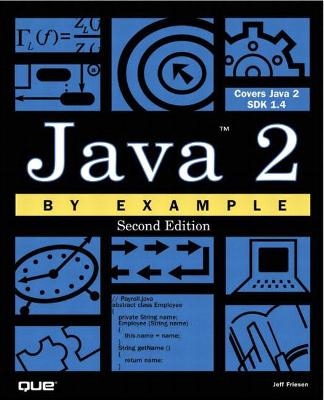
Java 2 by Example
Que Corporation,U.S. (Verlag)
978-0-7897-2593-6 (ISBN)
Java 2 by Example, Second Edition gives novice programmers in-depth coverage of both object-oriented programming and Java fundamentals. It starts with an overview of Java, including a survey of development tools beginners should use. The book explains the basics of the Java language, including operators, expressions, statements and more; and Object-Oriented Programming with classes and objects, inheritance, and dynamic methods. The author includes a chapter applying the concepts of OOP to object-oriented analysis and design methods. Later chapters demonstrate organizing data in collections and utilizing Java's built-in mathematical functions. Along the way, readers learn from hundreds of examples explaining every concept. Plus, each chapter ends with a series of review questions to ensure that readers are caught up - with answers provided in an appendix.
Jeff Friesen is heavily addicted to Java technology, to the point of choosing "Java Jeff" as his nickname. In addition to authoring this book, Jeff also co-authored Special Edition Using Java 2 Standard Edition. Furthermore, he has authored numerous Java-based articles for JavaWorld (ranging from internationalization to Java Plug-in to the future of Java) and InformIT.com (ranging from building your own media player to exploring Swing's table component) and is currently authoring JavaWorld's Java 101 column¿a column that presents a client-side Java course for beginners. In the past, Jeff taught his own university-level introductory Java course, and he served as the moderator of ITworld.com's Java Beginner forum, where he answered more than 1,000 client-side Java questions. Jeff holds a degree in computer science and develops software in C and C++. To find out what Jeff is up to, visit his Web site (http://www.javajeff.com).
Introduction.
I. EXPLORING THE LANGUAGE.
1. Introducing Java.
What Is Java? Development Tools. Java Programs. Java Versus C++. What's Next? Reviewing It. Checking It. Applying It.
2. From Unicode to Types.
Unicode. Comments. Identifiers. Types. What's Next? Reviewing It. Checking It. Applying It.
3. From Literals to Expressions.
Literals. Variables. Separators and Operators. Expressions. What's Next? Reviewing It. Checking It. Applying It.
4. Statements.
Types of Statements. Decision Statements. Loop and Loop Control Statements. Other Statements. What's Next? Reviewing It. Checking It. Applying It.
5. Classes and Objects.
Classes. Fields. Methods. Objects. What's Next? Reviewing It. Checking It. Applying It.
6. Inheritance.
What Is inheritance? The Root of All Classes. Interfaces. Inheritance Versus Composition. What's Next? Reviewing It. Checking It. Applying It.
7. Polymorphism.
What Is Polymorphism? Method Binding. Abstract Classes. Runtime Type Information. What's Next? Reviewing It. Checking It. Applying It.
8. Initializers and Nested Classes.
Initializers. Garbage Collection. Finalization. Nested Classes. What's Next? Reviewing It. Checking It. Applying It.
9. Exceptions and Exception Handlers.
What Are Exceptions? Throwing Exceptions. Catching Exceptions. Cleaning Up. What's Next? Reviewing It. Checking It. Applying It.
10. Threads.
What Are Threads? Synchronization. Scheduling. Thread Groups. What's Next? Reviewing It. Checking It. Applying It.
11. Packages.
What Are Packages? The Package Directive. The Import Directive. Playing with Packages. What's Next? Reviewing It. Checking It. Applying It.
II. EXPLORING APIs.
12. From Characters to String Tokenizers.
Characters. Strings. String Buffers. String Tokenizers. What's Next? Reviewing It. Checking It. Applying It.
13. From Fundamental Data Structures to Collections.
Fundamental Data Structures. Wrappers. Self-Referential Classes. Collections. What's Next? Reviewing It. Checking It. Applying It.
14. Mathematics.
Java and Mathematics. Essential Math Classes. Random Numbers. Big Decimals and Big Integers. What's Next? Reviewing It. Checking It. Applying It.
15. Files and Streams.
Working with Files. Working with Streams. Object Serialization. Stream Tokenizers. What's Next? Reviewing It. Checking It. Applying It.
III. APPENDIXES.
Appendix A. Answers to Quizzes.
Appendix B. Reserved Words.
Assertions.
Appendix C. Operator Precedence.
Appendix D. Additional Resources.
Certification.
FAQs, Forums, and Newsgroups. Magazines, Tutorials, and the Java Developer Connection. Glossary. Index.
| Erscheint lt. Verlag | 4.1.2002 |
|---|---|
| Sprache | englisch |
| Maße | 230 x 185 mm |
| Gewicht | 1383 g |
| Themenwelt | Mathematik / Informatik ► Informatik ► Netzwerke |
| Informatik ► Programmiersprachen / -werkzeuge ► Java | |
| Mathematik / Informatik ► Informatik ► Web / Internet | |
| ISBN-10 | 0-7897-2593-2 / 0789725932 |
| ISBN-13 | 978-0-7897-2593-6 / 9780789725936 |
| Zustand | Neuware |
| Haben Sie eine Frage zum Produkt? |
aus dem Bereich


